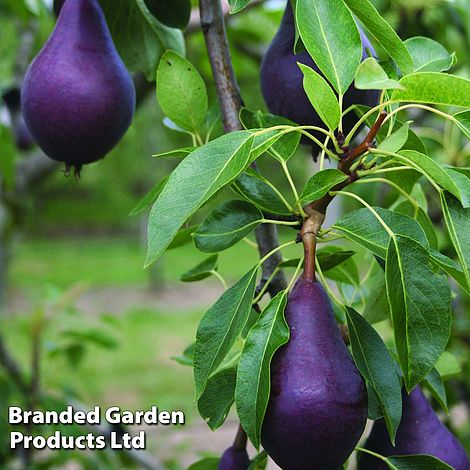




Pear 'Red William'Pyrus communis
Hardy
FROM £24.99
Red version of one of the most popular pear varieties
Just as sweet as the original
Added attraction of red skin and being slightly more dwarf
Pollination Group 3 - Eating Pear
 Height Up to 300cm (118.1in)
Height Up to 300cm (118.1in)
Spread Up to 300cm (118.1in)
 Hardy
Hardy
 kitchen gardenwildlife gardens
kitchen gardenwildlife gardens
 Full sun
Full sun
You May Also Like
Pear 'Red William' is a wonderful red version of one of the most popular pear varieties in the world. This red 'clone' is just as sweet as the original William's pear but with the added attraction of red skin and being slightly more dwarf than Pear 'Williams Bon Chretien'.
- Pear and Quince rootstocks:
- Quince C/ Quince Eline/ Quince Adams - Dwarf reaching a mature height of up to 2.5-3m (8-10')
- Quince A - Semi vigorous reaching a mature height of up to 3m (10') to 4m (13')
This variety is partially self-fertile. For the heaviest crops it is best grown with another variety. If you only have room for one tree then make sure that a neighbour has a tree close by that can act as a suitable pollinator. Pollination Group 3
Estimated time to cropping once planted: 2 years.
Estimated time to best yields: 5 years.
Useful links:
Show Codes
1 Bare Root Tree (Quince A Rootstock) (14148)
1 x 4.5 Litre Potted Plant (Quince A Rootstock) (KF3983)
Plant pear trees in any well drained soil in a sheltered sunny position. Prior to planting, incorporate plenty of well rotted manure or garden compost into the planting hole and drive the stake into the ground to support the tree. Staking after planting may result in damage to the root ball. Plant fruit trees at their original soil level and firm them into the ground. Fasten the tree to the stake using a tree tie, and water well. Pears will produce the best crops when planted near to another pear tree to increase pollination.
These plants are lifted from the nursery field when dormant, and sent to you in late autumn or spring for planting. They often look dead on arrival, but they are just resting in the dormant period and will establish quickly for a strong start in the garden come spring. Set out in prepared soil in holes wide enough and deep enough to lay out the roots. Tread down the planting soil to knock out air pockets. Water well to settle. Apply a mulch to protect roots from cold temperatures. If conditions prevent immediate planting, set roughly into loose soil or a pot of compost (‘heeling in’) to protect the roots. Set these at the same level as they were in the nursery field – you should see a soil line at the base of the stem. Stake trees, taller shrubs and roses to prevent root disturbance.
Fruit trees do not suffer weed competition well. Keep weeds and grass clear from within a 30cm radius of base of the tree. In spring, while the ground is moist, apply a mulch of well rotted manure or garden compost around the base of the tree, taking care not to mound it up against the stem. This will help to retain moisture throughout the summer. Feed pear trees regularly and water during particularly dry periods.
Pruning pear trees begins immediately after planting. Remove the central stem to just above the highest side branch. For the following 3 years, prune only the tips of the remaining main branches by one third in winter. Aim for about eight main branches which will form the frame of your tree, with fruiting sub branches growing off of them. From the fourth year, some sub branches can be pruned out at the union where they join the main branch, to allow new sub branches to take their place.
In order to produce the best quality, largest pears, the fruits should be thinned in July leaving one or two pears remaining per cluster.
Seeds and garden supplies will normally be delivered within the time period stated against each product as detailed above. Plants, bulbs, corms, tubers, shrubs, trees, potatoes, etc. are delivered at the appropriate time for planting or potting on. Delivery times will be stated on the product page above, or in your order acknowledgement page and email.
Orders for packets of seed incur a delivery charge of £2.99.
Orders which include any other products will incur a delivery charge of £6.99.
Where an order includes both packets of seeds and other products, a maximum delivery charge of £7.99 will apply - regardless of the number of items ordered.
Large items may incur a higher delivery charge - this will be displayed in your shopping basket.
Please see our Delivery page for further details, and more information on different charges that may apply to certain destinations.
For more information on how we send your plants please visit our Helpful Guide on plant sizes.
Recently Viewed
Sign Up For Exclusive Special Offers




© 2024 Thompson & Morgan. All rights reserved. A division of Branded Garden Products Limited.





















